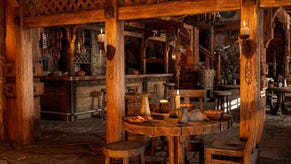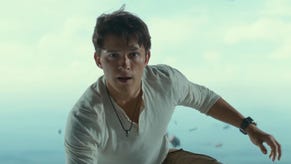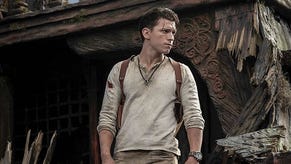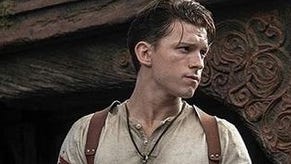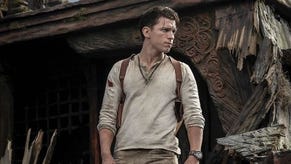Uncharted 3: Drake's Deception Review
Smoke and mirrors?
And Action. Nathan Drake, a blur of khaki and stubble, leaps from what must be the fiftieth rooftop high above the bustling streets of Yemen in pursuit of the be-suited villain. It's his sixth take ('life', in olde game parlance) in the most impressive chase yet seen in a video game, one directed with the kind of technical flair that wins Oscars. As he spills through a market stall, agitating chickens into a cloud of feathered squawks, the camera quick-pans to exaggerate the sense of kinetic drama.
Into the road and a stunt-car driver accelerates ten feet forward out of the wings, braking on the director's signal in just the right spot to allow Drake to tumble over the bonnet. Crash through a door and extras dressed as military police bark orders in machinegun-volley Arabic before retreating to the Green room for a sit down and a cup of tea.
No such respite for Drake, who leaps to grasp a window ledge with his fingertips then up and a dash to where a coat hanger turns a washing line into a 30-foot zip wire. Whoosh. And Cut.
Uncharted 3 is a game that has an unshakable sense of its own identity. The series has always had clear aims: an unapologetically mainstream Boy's Own romp whose primary interest is in creating unrivalled thrills through daring spectacle rather than daring design. But in this, the third outing, it has settled into the kind of assured swagger that comes from finding repeated successes in a specific creative mine.
Its greatest debts are to Saturday matinee cinema, Indiana Jones puzzles and pacing, Jewel of the Nile romances born in the kiln of perilous adventure; Han Solo quips. But at this point in the trilogy the designers have established a template of their own to follow.
It's a game in which the skin of your fingertips saves every rooftop leap, while each stonework puzzle solved in the belly of some inexplicably well-maintained tomb leads to another, yet more exotic continent. It's a game of button-mash punch-ups that leave neither blood nor bruise, and conundrums whose solutions pop up if you take too long to unmask them. It's a game about overcoming the odds, saving your friends, finding the treasure and getting the girl. Both of them.
Back to the rooftop chase, just one of any number of white-knuckle ride segments that lodge in the memory. The sequence demonstrates Naughty Dog's peerless talent for cinematic flair, often surpassing its movie inspirations for mastery of the action set-piece.
But it also reveals another truth. Uncharted 3 is the most exciting game in the world, but only until you deviate from the script. Even in this chase the conflict between the developer's theatrical choreography and player-controlled interactions is clear. In order to ensure each set-piece is set off correctly, the game commits the cardinal sin of insinuating you have full control of your character, but in fact tugging you towards trigger points - making sure you're in the right spot to tumble over the bonnet of that braking car, for example.
Likewise, mistimed leaps are given a gentle physics-defying boost to reduce the staccato rhythm of having to restart a section. It's entirely understandable given what the developer is attempting to achieve - an unbroken flow of action that leads to climax - but, at the same time, beneath the spectacle there's a nagging feeling that your presence in the scene is an irritation rather than a preference.
Your freedom of choice risks ruining the shot. Indeed, throughout the game, if you jump into an area you are not supposed to visit, Drake will crumple on the floor dead, Naughty Dog switching role from movie director to vindictive god. That is not your predestined path: Game Over.
This reluctance to give the player more than a supporting role can be seen in the use of one treasure at the core of the experience, a cipher-solving contraption once owned by Sir Francis Drake. Come up against a hieroglyphic that needs solving and, rather than giving you the chance to decipher the words using your own mind, your job is simply to press the button that pulls the gizmo out of Drake's pocket. He handles the rest. Your role, here at least, is one of interactive butler.
Frustratingly, you must always move at the script's pace. Enter a room with two giant cogs that need turning and Drake won't call over a comrade to help him until the correct sequence of cut-scenes has played out. The world is destructible, but only when Naughty Dog says so, and at times you cannot even un-holster Drake's gun, the developer simply disabling the button till the appropriate juncture. Oftentimes the game feels like a simple series of puzzles in which the puzzle is simply to locate the next trigger point for the drama.
The strict, linear design and tight camera management may contribute to a sense of being a semi-spectator on a fairground ride, but the benefit of this design approach is that it allows the team to focus every ohm of PlayStation processing power onto what is on screen at any one time. And so Uncharted 3 routinely stuns with its visuals. Turn a corner on a castle parapet and the camera pulls out just enough to take in the warm glow and detail of a French town far below. It is spectacular and the regularity of these jaw-dropping moments dizzies the mind.
Likewise, in the minutiae there's evidence of stunning workmanship as branches bend and swipe as Drake brushes past pot plants while special-case animations bring the supporting cast to vivid life. If the game's interactive design strains at a template laid down by the first game, then the world-building and presentation excels because of it. While the loss of agency grates, the developer's visual execution is peerless. It's impossible not to get swept up in the drama, and succumb to the ride.
Few risks have been taken with that ride, however, save perhaps for a couple of sections where drug-tipped darts cause havoc with the ensemble cast's minds, and some wonderful moments when the scriptwriters dip back into Drake and Sully's origin story.
It's a people-pleaser. Controversy has been eliminated from the curve of the game's progression with surgical precision, every bump in the road smoothed out by the footfall of a hundred play-testers. Some would argue that's best blockbuster practice, that Sony's Minis and indie Vita launch titles are the playpens for experimentation. But the result is that safe thrills and awe-inspiring spectacle are all that remain, sugar-rush gaming that sends your mind into repeated spasm but does little to reward beyond the immediate high.
The story races along with all the unapologetic chutzpah of a Wilbur Smith novel, the trio motivations of survival, treasure and friendship driving it at such a rate you've no time to notice its potholes. Nolan North's vocal turn as Drake is as assured as ever, while the hapless cockney good guy and Eton-educated bad guy tropes only contribute to the Hollywood aura.
The shooting - which next to puzzle-solving and scaling the environments makes up a third of the primary interactions in the game - is robust, guns feeling weighty and pleasing in the hands. Stealth is positively encouraged, but as soon as an AI soldier spots you so too does every enemy in the area, who instantly line up their sights on your position (even if you retreat to cover) with irritating telepathic prescience.
The series' single collectible currency of random relics that are left lying around the environments remains. However, there's very little sense of achievement or elation when you discover one, those feelings instead overwhelmed by a greater sense of irritation at the trinkets that you have no doubt missed. There is no reason to play the game twice beyond finding these.
Where repeated play is warranted, however, is in the assured multiplayer campaign, an entity so divorced from the single-player story that it's been available in its entirely as a download to PlayStation Plus subscribers for some time now. With a template borrowed from Modern Warfare, the meta-game is tried and tested with its experience points, medals awarded for any positive actions a player makes in the game, Boosters (Uncharted's take on Perks) and an emblem editor.
In play, however, the game is far more breezy and colourful than Infinity Ward's work, with zip-wires, loot drops, taunt animations and collectible relics (which unlock new clothes and emblems) to upset the familiarity of the competition. The success of the beta has proven this aspect of the game (which, avatars and controls aside, can at times feel like a separate game altogether) and it's here that, as so often is the case with contemporary blockbusters, the longevity is to be found. A short and sweet co-op adventure adds further interest, with perks and treasure drops to introduce a competitive element to the otherwise co-operative play arc.
Back in the main campaign and, as a slice of one-view entertainment, Uncharted 3 is peerless. The execution exhibits a kind of workmanship and polish way beyond the ambition of most other developers, let alone their abilities or budgets. As an expression of all that a video game could be, however, Uncharted 3 is narrow, focused and ultimately shallow. It is a majestic tribute to cinema, a movie game in the literal sense, and your enjoyment will be in precise step with your appreciation of that objective - and whether or not you believe it to be Drake's great deception, or Drake's great delight.



